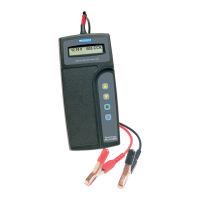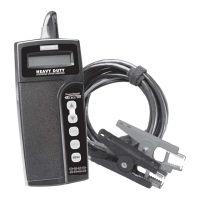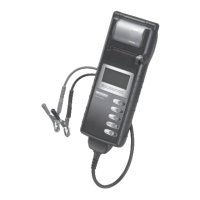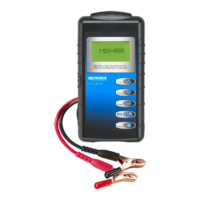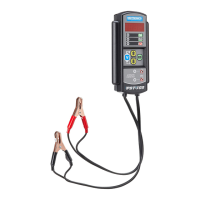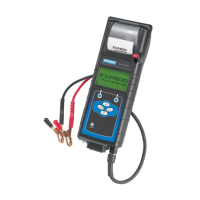The analyzer will determine if the charging system is able to provide
sufficient current for the demands of the vehicle’s electrical system.
When asked to turn on the accessory loads, turn on the high-beam
headlights, rear defogger, and the blower to high (heat).
6. The analyzer will begin testing the charging system with the loads
on and prompt you to rev the engine. Gradually increase the rpm
until the analyzer tells you to HOLD the rev level as the black bar
shown on the display crosses the line.
7. When the analyzer detects the rpm, it will prompt you to press
ENTER to continue.
8. The analyzer will display one of the following results:
CHARGING SYSTEM NORMAL: The system is showing normal
output from the alternator. No problem detected.
CHARGING SYSTEM PROBLEM: The analyzer detected a prob-
lem in the charging system and will display the following results:
NO CHARGING VOLTAGE: The alternator is not providing charg-
ing current to the battery. Check the belts to ensure the alternator
is rotating with the engine running. Replace broken or slipping belts
and retest. Check all connections to and from the alternator,
especially the connection to the battery. If the connection is loose or
heavily corroded, clean or replace the cable and retest. If the belts
and connections are in good working condition, replace the alterna-
tor. (Older vehicles use external voltage regulators, which may
require only replacement of the voltage regulator.)
LOW CHARGING VOLTAGE: The alternator is not providing suf-
ficient current for the system’s electrical loads and the charging
current for the battery. Check the belts to ensure the alternator is
rotating with the engine running. Replace broken or slipping belts
and retest. Check the connections from the alternator to the battery.
If the connection is loose or heavily corroded, clean or replace the
cable and retest. If the belts and connections are in good working
condition, replace the alternator. (In older vehicles that use external
voltage regulators, you may need to replace only the voltage
regulator.)
HIGH CHARGING VOLTAGE: The voltage output from the alterna-
tor to the battery exceeds the normal limits of a functioning regula-
tor. Check to ensure there are no loose connections and that the
ground connection is normal. If there are no connection problems,
replace the regulator. (Most alternators have a built-in regulator
requiring you to replace the alternator. In older vehicles that use
external voltage regulators, you may need to replace only the
voltage regulator.)
10
ENGLISH
GB

